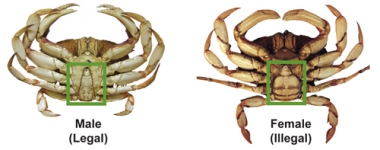
Crabs
Oregon crabbing is a year-round activity that can almost always yield a successful trip. Crabbing trips require minimal gear, often available for rental in coastal towns, and while boat crabbing increases your likelihood for success, dockside crabbing is easy and very accessible.
For all harvest of crab:
An ODFW Shellfish License is required.
Remove viscera before eating crab.
Call the Shellfish Safety Hotline at 1-800-448-2474 or visit ODA website before harvesting and consuming any shellfish.

Types of Crabs

While recreationally harvesting green crab has been allowed for decades, the Oregon Fish and Wildlife Commission recently increased the daily bag limit to 35 crab. This gives recreational shellfishers an opportunity to help native shellfish by taking more of these invaders home. European green crab are an invasive species in Oregon. While recreational harvest is allowed (35 per day), harvesters must correctly identify these crabs (see below) as they often are mistaken for native species. Commercially harvesting green crab is prohibited.
Green crab:
- Compete with native crabs for food.
- Larger green crab may eat smaller native shellfish.
- May disturb eelgrass beds important to native fishes and shellfish
Identifying green crab:
- FIVE SPINES ON THE OUTSIDE OF EACH EYE. Only invasive green crab have five spines outside of each eye.
- Three bumps between the eyes.
- Color is variable and can be green, black or yellow. There might also be white, yellow, orange, or reddish underneath and on leg joints.
- Adult crab shell (carapace) width is two to four inches. Usually found in mid-to-upper estuary areas.
- Know your target. Many native crab species (including Dungeness) are mistaken as green crabs. Molting Dungeness crab can also be green.
- Crab identification guide
Catching green crab:
- Gear used to harvest native Dungeness and red rock crab also works for green crab.
Green crab are here to stay
- Introduced to the U.S. West Coast during the mid-1990s, green crab populations persist though fluctuate widely based on environmental conditions.
- Local population increases or decreases are determined by supplies of larvae delivered by the ocean, and survival of juvenile and adult green crab.
- Ocean currents deliver green crab larvae to Oregon bays and estuaries from distant locations.
- During periods of warmer water (El Nino), green crab reproduction is more successful, and populations increase.
- Harvesting green crab alone is unlikely to decrease the population in the long run. Harvested numbers are quickly replaced by supplies of larvae delivered on ocean currents.
- ODFW and partner agencies monitor and research green crabs.

Features: Dungeness crab can sometimes be confused with rock or other crab species. However, it is easily identified by its white-tipped claws and reddish-brown to purple color.
Habitat: Adult Dungeness crab forage on a number of fish and invertebrate species. They can be found throughout the sandy and muddy areas in the shallowest parts of lower estuaries all the way to depths of almost 1,500 feet.
Techniques: There are many kinds of crab catchers – from crab pots and rings, to traps you can cast with a fishing rod. You can easily crab from a dock in many coastal bays, but a boat will give you access to more water. Boats and crab pots often can be rented at marinas and tackle shops. The relative number of crab in bays and estuaries depends on the water's salinity. When rivers are running high – as they do after a heavy rain – so much fresh water can pour into a bay that crab will move farther out into the ocean looking for saltier water.
Only male crab 5-3/4" or larger may be kept, so be sure you know how to identify and measure the crab you catch.

Features: These crab can be identified by their black-tipped claws, wide fan-shaped carapace (body cover) and deep, brick-red color.
Habitat: As the name implies, red rock crab prefer the harder substrate habitats such as rocks, pilings, and other structure. Red rock crab prefer higher salinities than Dungeness crab and therefore are usually found in larger estuaries, close to the ocean. They are most common in Coos, Yaquina, and Tillamook bays where there are plentiful rocky substrates. Red rock crabs are native to Oregon.
Techniques: Usually caught in combination with Dungeness crab, using the same techniques.




